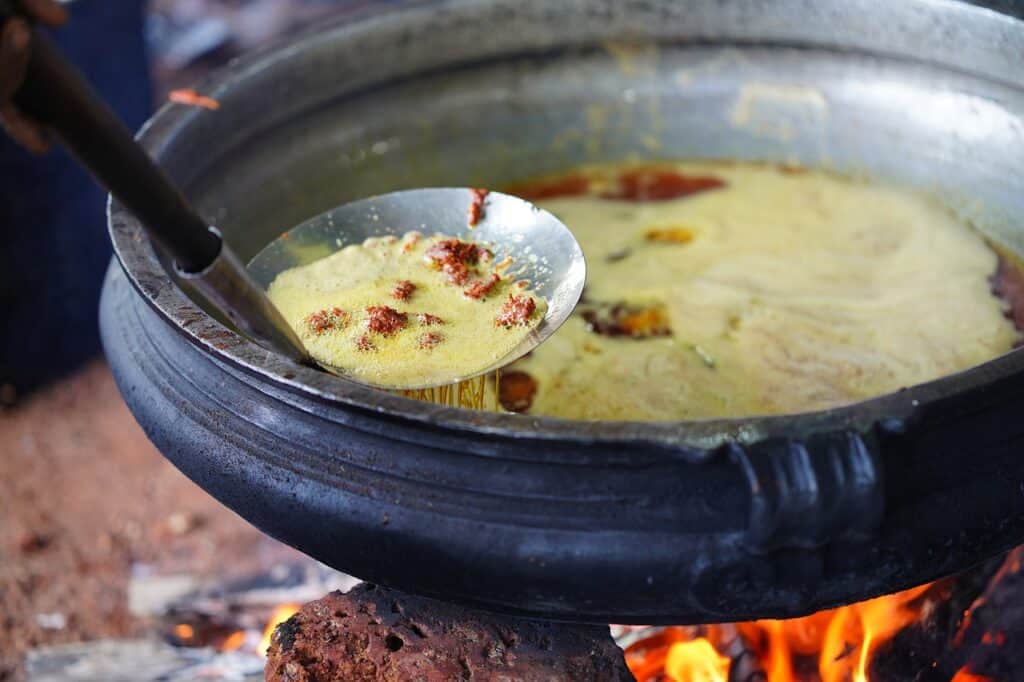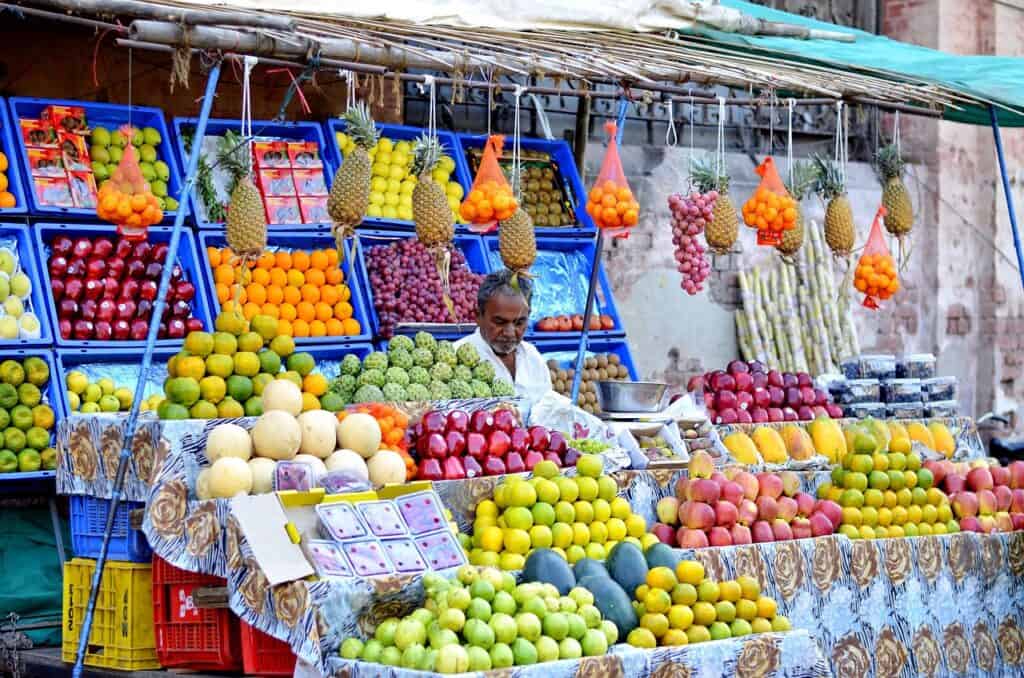Indian cuisine is amongst the most diverse and flavourful in the world. With a vast array of delectable dishes, cooking techniques, and ingredients influenced by historical and regional diversity, India offers an unparalleled culinary journey for the adventurous palate.
Tracing its origins back to the ancient Indus Valley civilization, Indian cooking has evolved over millennia through the intermingling of various cultures and culinary styles including Persian, Mughlai and European influences after foreign invasions. This rich history has resulted in one of the most unique and varied cuisines, making Indian food globally popular today.

In this comprehensive guide, I explore the history, regional diversity, cooking methods, ingredients and cultural role of food across India. Join us on an illuminating gastronomic adventure through the flavours of the Indian subcontinent.
A Culinary Journey Through India: Key Takeaways
| Section | Key Takeaways |
|---|---|
| Introduction | Overview of India’s diverse and influential culinary traditions. |
| Historical Palette | Influence of ancient cultures, Mughals, British, and Portuguese on Indian cuisine. |
| Regional Culinary Delights | Distinctive flavours from North, South, East, and West India. |
| Street Food Culture | Vibrant street foods like Chaat, Vada Pav, and Samosas as cultural staples. |
| Culinary Techniques & Ingredients | Traditional cooking methods and regional ingredients define Indian dishes. |
| Health, Wellness, and Indian Cuisine | Ayurveda and vegetarianism’s role in promoting health through diet. |
| Festivals and Food | Food’s central role in celebrating Indian festivals like Diwali and Eid. |
| Modern Innovations and Fusion Cuisine | Emerging trends blending traditional Indian flavours with global cuisines. |
| Culinary Tourism in India | Culinary tours and cooking classes offer deep dives into Indian cuisine. |
| Conclusion | Reflection on the importance of food in understanding Indian culture. |
The Historical Palette of Indian Cuisine
Indian cuisine has its roots in the ancient civilizations that first emerged around the Indus Valley and Ganges plains over 5,000 years ago. Food and cooking were given special importance in early Hindu texts and traditions, which went on to form the basis of many dietary habits still followed today.
The Vedic period saw the establishment of grain cultivation and the domestication of cattle, shaping early staples like rice, lentils and dairy which still dominate parts of India. Spices were always integral to Indian cooking, used both for flavour and Ayurvedic wellness properties. The ancient Sanskrit treatise Bhojanakutuhalam contains some of the earliest known recipes.
A defining point arrived in the 16th century with the Mughal Empire, when Persian and Central Asian influences brought rich dishes like biryani, korma and tandoori cooking. Mughlai cuisine remains hugely popular across North India. The Portuguese and British later introduced chillies, potatoes, tea and bread. This blending of diverse culinary styles over centuries shaped the complex flavours of modern Indian food.
Today, Indian cuisine varies greatly from north to south, with distinctly different regional cuisines native to each state, while the underlying use of spices and herbs for health remains unchanged since ancient times.
Regional Culinary Delights
With 29 states, each with unique cultures, ingredients and cooking methods, Indian cuisine takes one on an incredible food journey across the regions.
North India
North Indian food is best known for its rich curries and extensive use of dairy products. An influence of the Mughlai Empire and Central Asia is evident in dishes like kebabs, koftas and the quintessential Butter Chicken.
Fluffy naan bread baked in earthen tandoor ovens is a speciality. The iconic tandoori chicken marinated in yoghurt and spices is another northern staple. Thick, meaty curries like Rogan Josh and fiery vindaloo are popular. Chaat, the sweet and tangy snack, also hails from North India’s streets.
South India
In comparison to the North, South Indian cuisine uses less dairy and more rice, lentils and coconut. Staples like dosa, idli and vada paired with sambar and chutney are famous exports, while Chettinad pepper chicken provides some heat.
The coastal regions of Kerala and Goa excel in seafood like fish curries, crab masala and spicy shrimp fry. Desserts like payasam pudding and sweet rice dish kheer are southern comfort foods.
East India
Eastern Indian food shares similarities with South Indian cuisine while retaining its own distinctive flavour profile. Fish and rice dominate mealtimes, with fresh river fish curries popular in West Bengal and Odisha.
Sweets play a big role here. Rosogolla, the iconic syrupy cheese balls from Bengal are world famous along with chhena based desserts like rasmalai. Winter delicacies like narkel naru and pitha rice cakes stuffed with coconut or jaggery are unique offerings.
West India
The diverse western region offers both fiery inland cuisine and fresh coastal seafood. Maharashtrian fare like hot mutton vindaloo, mild coconut-based kombdi curry and the humble but iconic Vada Pav burger are popular.
In Gujarat, the predominantly vegetarian Jain community has influenced staples like the elaborate Gujarati thali meal, dal dhokli and a host of fried snacks. Parsi cuisine offers Persian-influenced berry pulao, sweet and sour fish dishes and amazing patisserie.
Goan food is dominated by Portuguese-inspired seafood like fish caldin, prawn balchao and the iconic Goan vindaloo curry.
Street Food: The Heartbeat of India

While fancy restaurants have their place, no culinary journey through India is complete without exploring the bustling world of street food. From tasty bites served out of modest carts and stalls to entire markets dedicated to regional chaat and snacks, Indian street food reflects the very soul of the country.
Spicy, tangy and incredibly tasty, chaat encapsulates the riot of sweet, sour and spicy flavours that Indian street food is loved for. Aloo tikki, pani puri, bhel puri and dahi bhalla are just some of the mouthwatering chaat specialities found across North India’s roadside stalls.
No discussion on Indian street food is complete without the ubiquitous Vada Pav – a vegetarian cousin of the burger, comprising a fried potato patty sandwiched between halves of a tiny bread bun. It originated in Mumbai but has now spread as a much-loved fast food across India.
Crunchy samosas stuffed with spiced potatoes and peas are another favourite snack from Punjab now popular globally. Street food in India also offers unique regional specialities like Bengali jhal muri puffed rice snack to paper-thin dosas of South India and Gujarati dhoklas.
Culinary Techniques and Ingredients

Indian cooking utilizes a wide range of ingredients and methods. Complex blending of spices is integral to most Indian dishes. Regional cuisines also use certain signature processes to achieve appetizing flavours.
Tandoori cooking uses the high heat of a clay tandoor oven to roast meats and bread like naan to perfection. Originating in North India, tandoori dishes like chicken and fish tikka are now loved globally.
Dum Pukht is a slow cooking technique often used for meat curries, where ingredients are sealed and cooked gently in their own juices on low flame. This tenderizes meat deeply and develops a smooth, rich gravy-like in dum aloo or Hyderabadi biryani.
Local ingredients also impact regional cuisines. Coconut and curry leaves flavour South Indian dishes. Goan and coastal cooking uses kokum, a sun-dried fruit adding tangy sourness to fish curries. North Indian curries get their richness from dairy, nuts and dried fruit.
Health, Wellness, and Indian Cuisine
Indian cuisine has a deep connection with wellness and healing, with food and health believed to be directly related according to ancient Indian medicinal practice Ayurveda. Spices and herbs are used liberally in dishes not just for flavour but also for their digestive, anti-inflammatory and antioxidant properties.
Components of an Indian meal like dal, rice, roti, raita and chutney are designed to provide balanced nutrition. Cooling foods like cucumber raita balance spicy curries. Herbs like turmeric, cumin, coriander seed and fenugreek add both flavour and medicinal value to dishes.
Vegetarianism has been followed in parts of India since ancient times either for religious beliefs or lack of access to meat. Consequently, Indian cuisine boasts a vast repertoire of vegetarian dishes that are not just healthy but also packed with flavorful spices, grains and produce. Popular vegetarian foods like dal makhani, palak paneer and aloo gobi are now loved globally.
Festivals and Food: A Cultural Symphony

In Indian culture, food and festivals share an intimate connection. Different festivals have specific traditional foods associated with their celebrations that are prepared in homes and enjoyed communally.
Diwali, known as the Festival of Lights, is incomplete without an array of delectable sweets like gujiya pastries, shakarpara crisps and chocolate barfi. Savoury snacks like chivda mix, chakli and sev are also popular.
Eid calls for a lavish spread of biryani, kebabs and rich korma to celebrate. During the colourful festival of Holi, sweet and spicy gujia pastries and thandai drink infused with bhang are essential. Specific dishes reinforce cultural and social bonds during Indian festivities.
Modern Innovations and Fusion Cuisine
While traditional recipes are preserved as heritage, Indian food has also evolved with globalization and cross-cultural influences. The intermingling of diverse culinary ideas has given rise to innovative fusion food that combines the ‘best of both worlds’.
Popular Indian dishes like chicken tikka masala, butter chicken and dal makhani have undergone innovative tweaking in foreign lands, developing new avatars like butter chicken pizza, dal makhani tacos and curry leaf pasta.
This fusion food aims to cater to evolving tastes without compromising on the distinctive Indian flavours. Trends like modernist gastronomy using molecular techniques are also making headway into high-end Indian restaurants for experimental menus. Contemporary plating styles and global ingredient pairings are also emerging in cities.
The availability of regional ingredients like ghee, curry leaves and chillies in foreign supermarkets has further fueled experimentation by home cooks and chefs internationally. Indian cuisine is thus continuously evolving while retaining its traditional culinary roots.
Culinary Tourism in India

India offers a vibrant culinary tourism landscape for food lovers to not only taste but also actively learn about regional cooking traditions. Numerous food tours, cooking classes and gourmet trails are available across India’s cities and villages.
Kerala in South India has emerged as a prime destination for culinary holidays owing to its rich cuisine and healing traditions. Packages offer spice garden tours, cooking lessons and Ayurveda therapy combined with local feasts.
North India boasts the Golden Triangle food tour covering Delhi, Agra and Jaipur, offering cooking demos, street food trails and fine dining at erstwhile royal kitchens. West Bengal is renowned for village tours sampling authentic Bengali cuisine in local homes.
Culinary tourism thus provides a pathway for cultural exchange and to savour genuine flavours of the land for an insider’s perspective of Indian cuisine.
Final thoughts
The culinary expedition through India reveals a cuisine that is ancient yet modern, steeped in tradition yet innovative, and diverse yet unified in its celebration of flavors. Regional distinctions give rise to endless taste discoveries from North to South, while the underlying use of aromatic spices and herbs binds the cuisine.
From ancient Sanskrit texts outlining Ayurvedic properties of native ingredients to fusion experiments blending cuisines across continents, Indian food has continuously evolved. The cuisine preserves old-world cooking techniques like dum pukht and tandoori roasts yet also embraces modernist gastronomy.
Food and festivals continue to be inextricably linked in Indian culture. As celebrations evolve to meet changing times, so does the cuisine by assimilating new influences. Yet the soul of the food remains unchanged.
The global popularity of Indian cuisine today is a testament to the richness of the fare. As culinary travellers seek authentic yet immersive food experiences, India promises a sensory and spiritual journey that satiates more than just the stomach. It opens up pathways to understand the very essence of the land and her people.
FAQs
Q: What is the best time of year to visit India for a food tour?
A: October to March is ideal with cooler weather. Regional festivals also fall during this period with unique dishes to sample. However, April-September offers mango season specialities in the North and summer delicacies like aamras in the West/South.
Q: How can I safely enjoy street food and avoid getting sick?
A: Check that cooked food is served hot and that raw ingredients look fresh. Local tap water and ice should be avoided. Opt for bottled water and hot tea/coffee. Only eat at busy stalls with high turnover and be mindful of hygiene.



